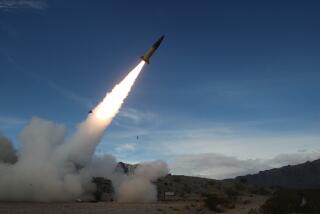U.S., Russia to Jointly Staff Missile Center
- Share via
WASHINGTON — The United States and Russia have agreed to jointly staff a Colorado command center that will monitor missile early-warning data to avert potential mishaps caused by the Y2K computer bug, U.S. officials said Friday.
For a few weeks in late December and early January, U.S. and Russian military officials for the first time will sit side by side and review information generated by satellites programmed to detect missile activity around the world.
U.S. defense officials, who have struggled for years to encourage this kind of cooperation, hope the Y2K experience will lead to creation of a permanent joint early-warning center in Moscow.
Officials from both countries began collaborating last year in an effort to prepare for the possibility that some military systems will go haywire with the arrival of 2000, which could be interpreted as 1900 by older hardware and software. But Russia halted its participation in the discussions this spring to protest the NATO bombing campaign in Kosovo.
The agreement to jointly staff the Center for Y2K Strategic Stability in Colorado Springs will be signed Monday in Moscow by U.S. Defense Secretary William S. Cohen and Russian Defense Minister Igor D. Sergeyev, according to a senior U.S. defense official who requested anonymity.
Although the security of Russia’s aging nuclear weapon systems has been one of the scariest issues associated with the Y2K phenomenon, U.S. officials say there is virtually no possibility that the “millennium bug” could cause an accidental missile launch.
But, they say, it is conceivable that a Y2K glitch could cause one or more of Russia’s early warning satellites to generate false data or shut down entirely. Should that occur, Russian officials in Colorado Springs could relay accurate information to their colleagues in Russia.
“It’s not because we think we’re . . . teetering on the edge of a potential false launch or anything of the sort,” said the senior Defense Department official. “And at this time of Y2K transition, were there to be some sort of problem, it would certainly be useful to have our people in direct contact and direct communication with one another.”
U.S. officials and nonproliferation experts hope the collaboration will help build trust and, over time, enable U.S. military officials to play a larger role in maintaining the security of the remaining nuclear arsenal of the former Soviet Union.
“This clearly is a useful thing to do,” said Spurgeon Keeny, president of the Arms Control Assn., a nonprofit organization in Washington. “It’s a confidence-building measure running up to [Jan. 1] and a possible safety net if something goes wrong.”
If all goes as planned, about 20 Russian military officers will arrive at Peterson Air Force Base in late December and report for duty on the second floor of Building 1840, an office complex just inside the gates of the Colorado base.
The joint operations will occur in a room furnished with clusters of desks equipped with computers and monitors, a large video display and a red telephone connected to a secure line to Russia. In the event that Russia’s early warning system malfunctions, strategic control officers in Russia will be able to use the hotline to contact their emissaries in Colorado Springs.
The center will be staffed 24 hours a day, seven days a week, beginning in late December and continuing for the first week or two of January.
The joint mission will have access to “processed” U.S. early warning information but not the raw data monitored by strategic command officers at the North American Air Defense operation in Cheyenne Mountain, Colo.
Originally, U.S. officials had wanted to supply the Colorado Springs center with data generated by both the Russian and U.S. early warning systems. But Russian officials balked at the idea of revealing the strengths and weaknesses of their system to Americans, according to the U.S. defense official.
On Capitol Hill, congressional committees focusing on the Y2K problem view the security of the Russian nuclear arsenal as one of their top concerns.
“Over the past few years, Russians have had close calls because their early warning system is decaying,” said a House aide working on Y2K and military issues.
The Russians, for example, have misinterpreted satellite launches by other countries as missile launches, the aide said.
“With the degradation of their early warning systems, they could see something during [Y2K] rollover . . . that would look to them like a launch,” the aide said, “or computers could give them a false reading, or someone maliciously could give them a false warning.”
The Russian military is trying to make its early warning systems “Y2K-compliant,” but some non-government analysts fear that the effort will not succeed in removing all of the potential computer bugs.
“It’s not clear if they’re going to finish repairs on time, and they don’t have a lot of time to test their repairs,” said Michael Kraig, a consultant for the British-American Strategic Information Council, a nonprofit research and policy organization.
In the past, both the U.S. and Russian early warning systems have generated false information. In 1983, for instance, a Soviet satellite sent false signals indicating a U.S. nuclear attack was underway. It was up to a Soviet lieutenant colonel on the ground to decide whether five U.S. Minuteman intercontinental ballistic missiles were en route to Russia. He concluded it was a false warning, and a potential catastrophe was averted. As it turned out, the satellite had detected the sun’s reflection off clouds and mistaken it as a missile launch.
“Given the past record of accidents without Y2K, it would be imprudent to assume that Y2K was incapable of producing errors like those created in the past,” Kraig said.
More to Read
Sign up for Essential California
The most important California stories and recommendations in your inbox every morning.
You may occasionally receive promotional content from the Los Angeles Times.










